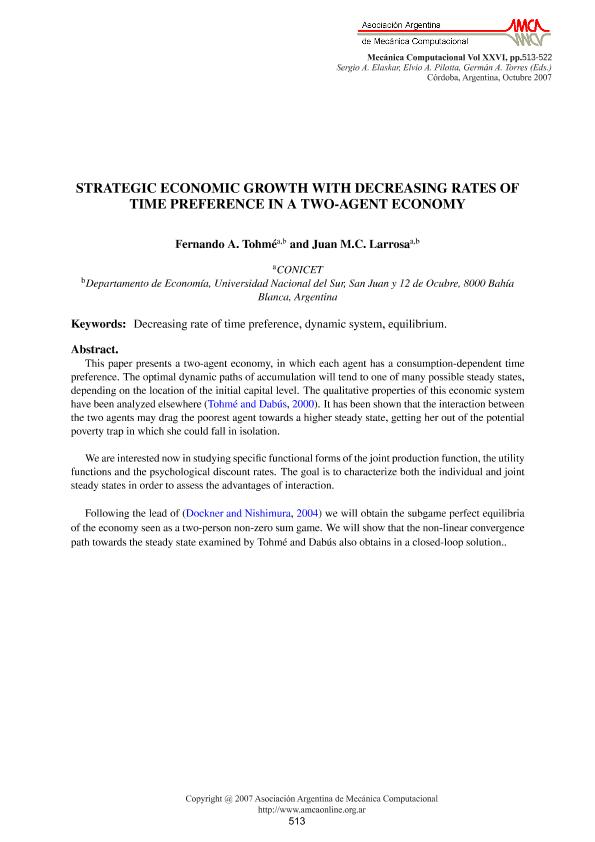Artículo
Strategic economic growth with decreasing rates of time preference in a two-agent economy
Fecha de publicación:
10/2007
Editorial:
Asociación Argentina de Mecánica Computacional
Revista:
Mecánica Computacional
ISSN:
1666-6070
Idioma:
Inglés
Tipo de recurso:
Artículo publicado
Clasificación temática:
Resumen
This paper presents a two-agent economy, in which each agent has a consumption-dependent time preference. The optimal dynamic paths of accumulation will tend to one of many possible steady states, depending on the location of the initial capital level. The qualitative properties of this economic system have been analyzed elsewhere (Tohm´e and Dab´us, 2000). It has been shown that the interaction between the two agents may drag the poorest agent towards a higher steady state, getting her out of the potential poverty trap in which she could fall in isolation. We are interested now in studying specific functional forms of the joint production function, the utility functions and the psychological discount rates. The goal is to characterize both the individual and joint steady states in order to assess the advantages of interaction. Following the lead of (Dockner and Nishimura, 2004) we will obtain the subgame perfect equilibria of the economy seen as a two-person non-zero sum game. We will show that the non-linear convergence path towards the steady state examined by Tohm´e and Dab´us also obtains in a closed-loop solution.
Palabras clave:
Decreasing Rate of Time Preference
,
Dynamic System
,
Equilibrium
Archivos asociados
Licencia
Identificadores
Colecciones
Articulos(CCT - BAHIA BLANCA)
Articulos de CTRO.CIENTIFICO TECNOL.CONICET - BAHIA BLANCA
Articulos de CTRO.CIENTIFICO TECNOL.CONICET - BAHIA BLANCA
Articulos(IIESS)
Articulos de INST. DE INVESTIGACIONES ECONOMICAS Y SOCIALES DEL SUR
Articulos de INST. DE INVESTIGACIONES ECONOMICAS Y SOCIALES DEL SUR
Citación
Larrosa, Juan Manuel Ceferino; Tohmé, Fernando Abel; Strategic economic growth with decreasing rates of time preference in a two-agent economy; Asociación Argentina de Mecánica Computacional; Mecánica Computacional; 26; 10-2007; 513-522
Compartir




